Over millennia of traditional craftsmanship, the production of sơn mài or Vietnamese lacquer painting, has evolved into a refined art form, celebrated for its use of natural and sustainable resources. Vietnamese lacquer is often synonymous with cultural heritage, as evidenced by aesthetic products and renowned works of art in Vietnam and around the world. Read on to discover the history of Vietnamese lacquerware and its infinite potential!
1. What is ‘Vietnamese lacquerware’?
This refined art stems from a technique used since the Ly dynasty (11th-12th centuries) to protect objects and decorate or gild paintings and statues in pagodas using lacquer. Lacquer, extracted from the laquier tree in northern Vietnam, is harvested in the same way as rubber, by incision and sap flow. Toxic in its liquid state, it becomes solid and neutral once dried, providing a coating renowned for its strength, durability and brilliant aesthetic appeal.
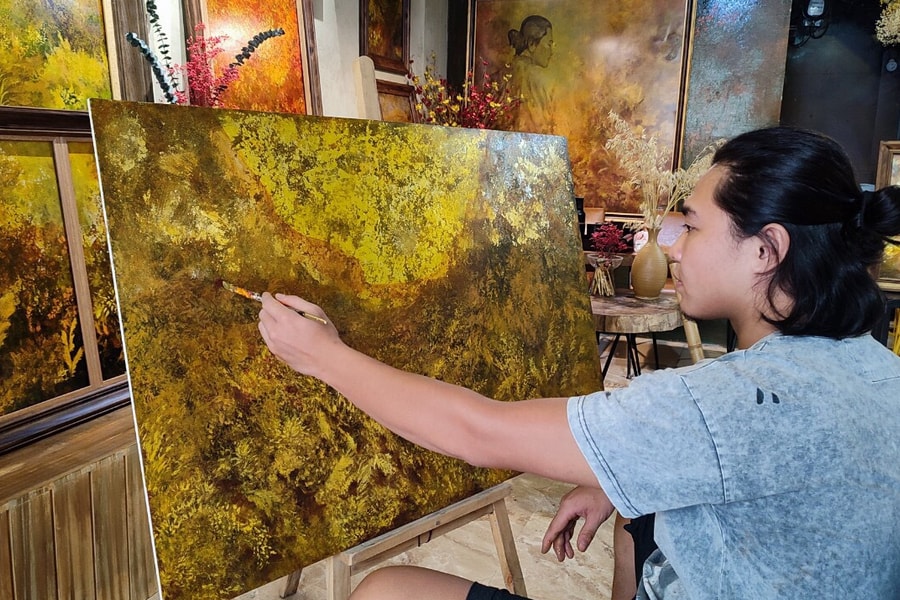
Vietnamese lacquer colours are created by adding natural pigments to a raw brown resin base, used as a varnish. The fired resin, obtained through a process of heating and oxidation, is used to produce the black colour. The other main colours, such as red, green, brown and white, come from mineral powders.
The distinguishing feature of the lacquer technique is the application of multiple layers and meticulous polishing, with drying in a humid environment. Sanding then reveals varied shapes and colours, creating unexpected effects and leaving room for improvisation and creativity, making lacquer an art rich in possibilities for research and creation.
2. A meticulous and complex process
The art of Vietnamese lacquerware is the fruit of hard work, requiring a great deal of time and effort. Each piece, large or small, goes through more than 20 manual stages, taking around three months to complete. Here’s an overview of the main techniques used:
- Preparation of the support (Mộc) : Craftsmen shape the object in wood, MDF or synthetic fibres, making sure the surface is smooth and flawless, then apply a layer of glue to protect it.
- Hom: The support is covered with a mixture of natural lacquer, stone powder, fine earth, sawdust and silt, then reinforced with a fine cotton cloth to increase strength and prevent cracking.
- Smoothing (Lót): Once dry, the substrate receives a coat of lacquer, followed by wet sanding to smooth the surface, then another coat of lacquer is added.
- Eggshell inlay (Cẩn trứng): After several coats of homage, eggshells are precisely inlaid to create delicate patterns.
- Intermediate polishing (Mài lót): A coat of natural lacquer is applied to the entire object, with clear lacquer on the motifs, followed by sanding to obtain a smooth surface.
- Application of gold or silver leaf : Very fine gold or silver leaf is delicately applied to the motifs and adjusted to fix them in place.
- Colouring (Vào màu): The colours are carefully applied to ensure an even, smooth layer.
- Polishing the colours (Mài màu): This polishing of the coloured layers, combined with other steps, gives the surface a shiny, smooth appearance.
- Hand-painting or engraving: Artisans sculpt or paint unique designs by hand, often inspired by Vietnamese nature.
- Gloss or matt finish: A finish is applied to protect the surface and give it a modern look.
- Final polishing (Mài quang) and buffing (Đánh bóng): The object is polished and buffed one last time to obtain a perfectly smooth, shiny surface.
3. Lacquer painting in Vietnamese fine art
Vietnamese lacquer art evolved and reached its apogee in the 1930s with lacquer painting. Students at the Indochina School of Fine Arts revitalised this medium by incorporating French techniques.
Among the renowned artists, Nguyễn Gia Trí is recognised as the master of Vietnamese lacquer painting. Influenced by realist and impressionist styles, he focused on themes such as graceful young women in romantic natural settings. His mastery elevated lacquer to the status of a major art in Vietnam, and many of his works are considered national treasures, such as Vườn xuân Trung Nam Bắc (Spring Garden of the Northern, Central and Southern Regions) and Thiếu nữ bên hoa phù dung (Young Woman Beside the Hibiscus Flower).
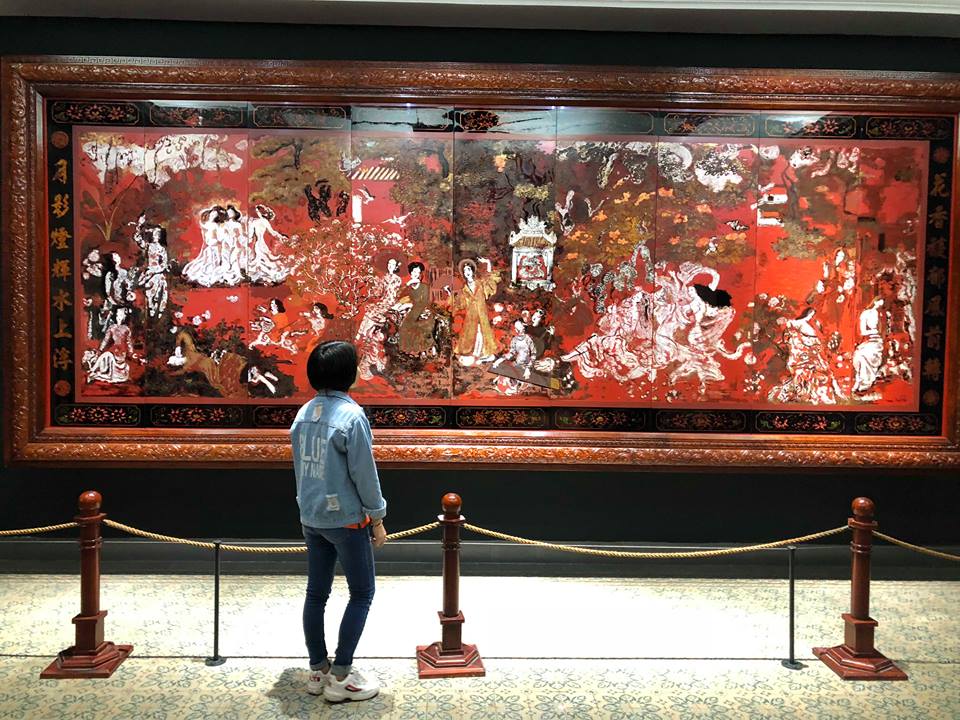
Other artists also contributed to making this style known. Lê Quốc Lộc is renowned for his paintings of natural landscapes and resistance war scenes. His “Landscape of Phnom Penh ’ is widely regarded as his masterpiece. Tran Phuc Duyen, who often focuses on Vietnam or themes related to his homeland, is famous for his work Halong Bay, reflecting his deep sense of nostalgia. Phạm Hậu, famous for his painting Chùa Thầy, often tackles themes of pagodas, rural landscapes of the northern and central regions, as well as rivers and goldfish.
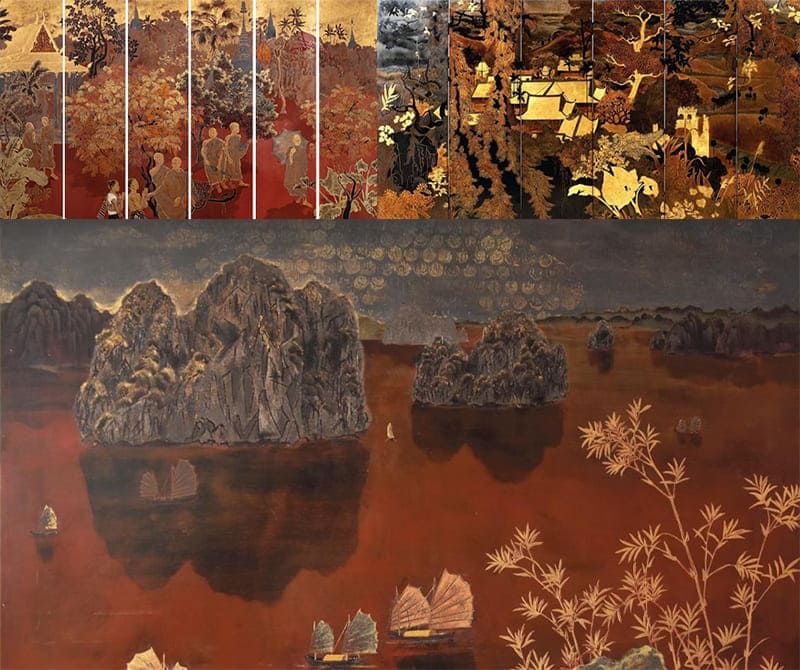
Nguyễn Sáng ‘s lacquer paintings are particularly notable for their innovative use of materials and engagement with social and cultural themes. His works, recognised as national treasures, are protected by the government and symbolise Vietnam’s pride and cultural identity, including Kết nạp Đảng ở Điện Biên Phủ (Party admission ceremony in Dien Bien Phu) and Giặc đốt làng tôi (The Invaders Burned My Village).
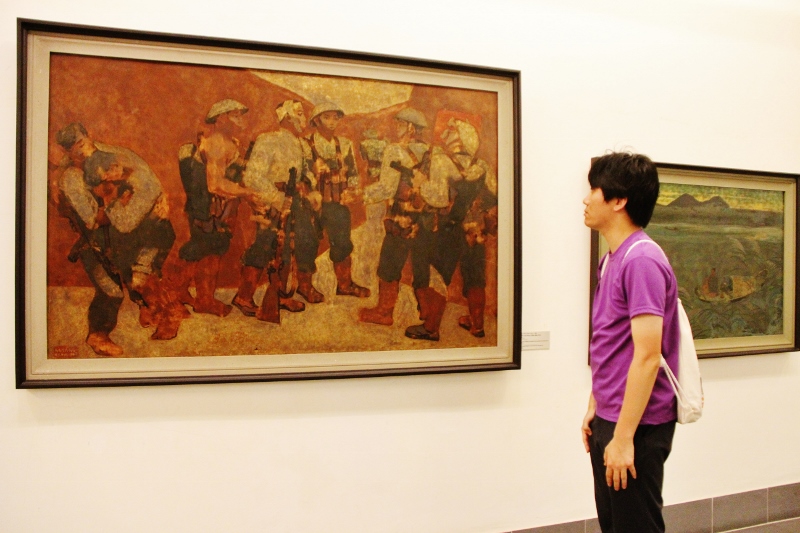
Where to admire the lacquer paintings?
Vietnam Fine Arts Museum
- Address: 66 Nguyen Thai Hoc street, Ba Đinh district, Hanoi
- Prices: 20,000-50,000 VND
- Opening hours: 8.30am – 5pm, Monday to Sunday.
Ho Chi Minh City Museum of Fine Arts
- Address: 97A Pho Duc Chinh Street, District 1, Ho Chi Minh City
- Admission: VN30,000
- Opening hours: 8am-5pm, Monday to Sunday
4. Where can buy Vietnamese lacquer painting?
Ha Thai lacquerware craft village
The village of Hạ Thái, near Hanoi, is Vietnam’s most famous lacquerware craft village. Its history began in 1931 when Đinh Văn Thái, after learning lacquer painting at the Indochina School of Fine Arts, returned to teach the locals this art. Since then, this skill has been passed down from generation to generation, becoming a rich tradition.
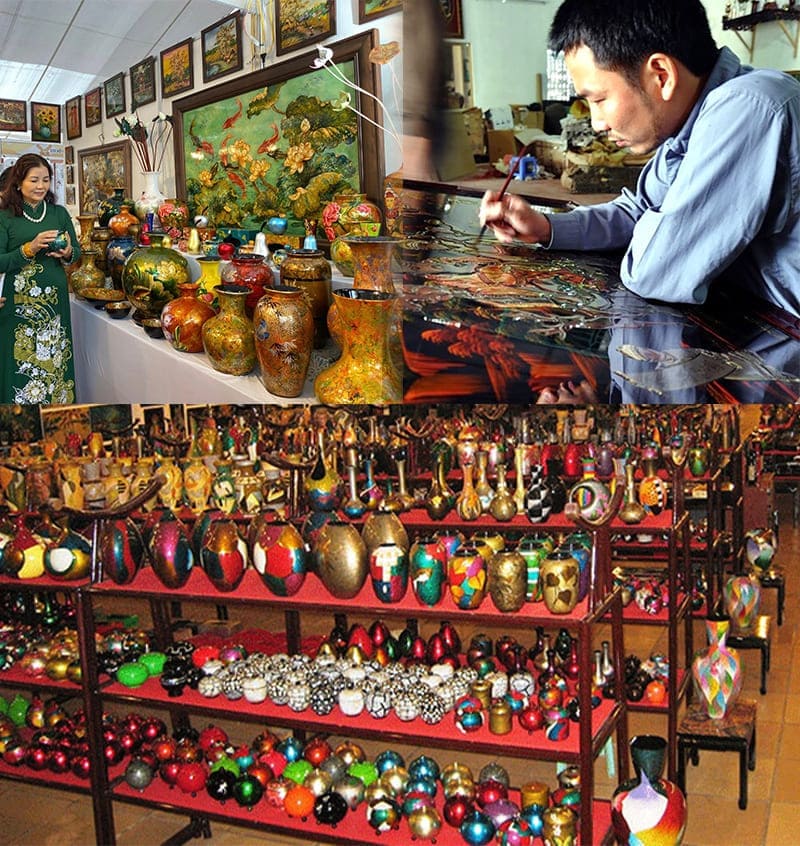
What sets Ha Thai apart is its ability to fuse traditional techniques with modern designs. Craftsmen innovate by skilfully combining ancestral methods and contemporary creations to enrich the art of sơn mài (Vietnamese lacquerware).
Tuong Binh Hiep lacquer village
Located 20 km from Ho Chi Minh City, in Binh Duong province, Tuong Binh Hiep village has the longest lacquerware tradition in Vietnam, with over 600 years of history.
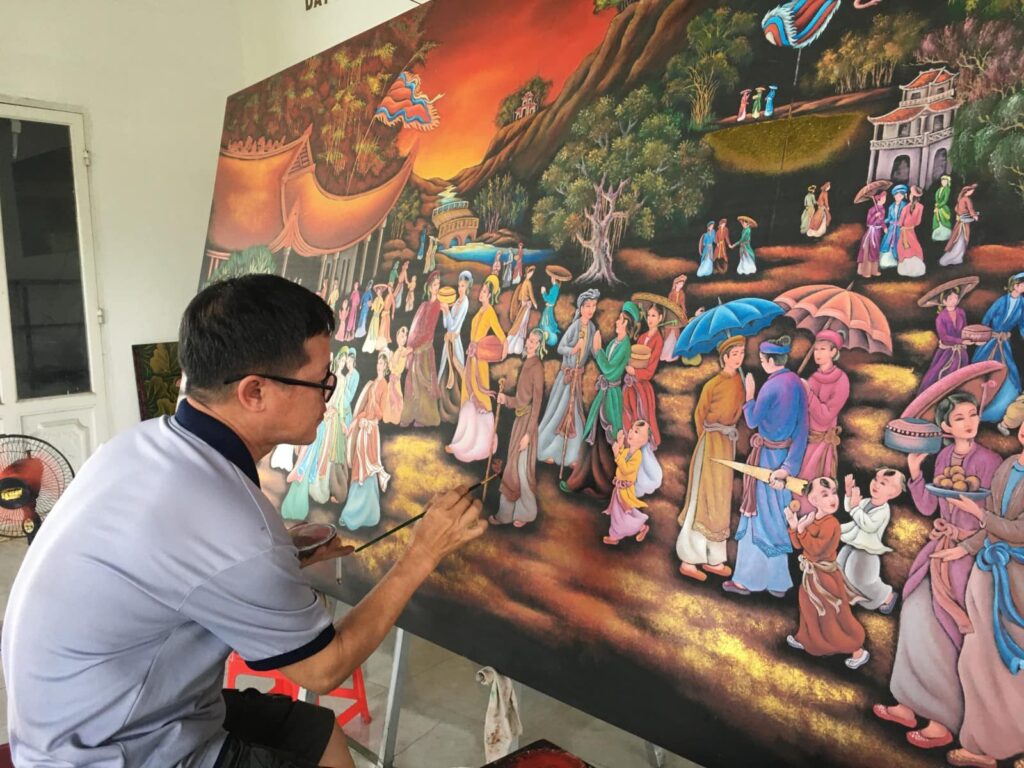
True to its roots, the village preserves traditional, meticulous manufacturing methods using natural materials such as raw lacquer, gold leaf and mother-of-pearl, without major modifications. Tuong Binh Hiep stands out for its commitment to traditional craft techniques, producing authentic objects of great historical value.
Vietnamese lacquerware shops
Hanoia:
Address: Lane 2, Le Van Huu Street, Hai Ba Trung District, Hanoi
Located in the heart of the city, Hanoia is one of the most prestigious brands for high-quality lacquerware. Hanoia’s creations are distinguished by their fusion of tradition and modernity, using ancestral craft techniques.
Saigon Crafts:
Located in District 1, Saigon Crafts offers a varied collection of lacquerware, from wall decorations to desk accessories, all handmade.
5. How should lacquerware be stored?
Creating a piece of lacquerware takes a great deal of time and effort, reflecting the artistic commitment of the craftsmen. To maintain their quality, it is essential to protect them carefully.
- Avoid direct sunlight and high temperatures to prevent fading and damage.
- Keep objects in a balanced environment, avoiding damp and dark places to prevent mould.
- In cold conditions, place objects flat with a light weight on them for a few weeks to avoid warping.
- Use a dry or slightly damp cloth to clean the surface, without chemicals or hot/cold water.
- For stains, rub gently with your fingers or a dry cloth and a mild product such as Cana.
- Avoid sharp or hard objects to avoid scratching the lacquer surface.
Sơn mài or Vietnamese lacquer painting, is one of Vietnam’s most iconic and distinctive art forms, renowned for its richness and authenticity, distinguished by its finesse and elegance. With its ancient origins and modern development, Vietnamese lacquer has succeeded in harmoniously blending the past and the present.
